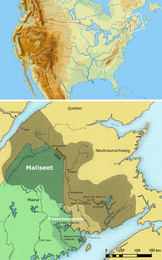Mi'kmaq
The Mi'kmaq (also Mi'gmaq, Lnu, Miꞌkmaw or Miꞌgmaw; English: /ˈmɪɡmɑː/ MIG-mah; Miꞌkmaq: [miːɡmaɣ])[4][5][6] are a First Nations people of the Northeastern Woodlands, indigenous to the areas of Canada's Atlantic Provinces, primarily Nova Scotia, New Brunswick, Prince Edward Island, and Newfoundland,[7] and the Gaspé Peninsula of Quebec as well as Native Americans in the northeastern region of Maine. The traditional national territory of the Mi'kmaq is named Miꞌkmaꞌki (or Miꞌgmaꞌgi).
This article is about the people. For other uses, see Mi'kmaq (disambiguation).
Lnu
There are 66,748 Mi'kmaq people in the region as of 2023, (including 25,182 members in the more recently formed Qalipu First Nation in Newfoundland.[8][9]) According to the Canadian 2021 census, 9,245 people claim to speak Miꞌkmaq, an Eastern Algonquian language.[10] Once written in Miꞌkmaw hieroglyphic writing, it is now written using most letters of the Latin alphabet.
The Mi'kmaq, Maliseet, and Pasamaquoddy nations signed a series of treaties known as the Covenant Chain of Peace and Friendship Treaties with the British Crown throughout the eighteenth century; the first was signed in 1725, and the last in 1779. The Miꞌkmaq maintain that they did not cede or give up their land title or other rights through these Peace and Friendship Treaties.[11] The landmark 1999 Supreme Court of Canada decision in R v Marshall upheld the 1752 Peace and Friendship Treaty "which promised Indigenous Peoples the right to hunt and fish their lands and establish trade."[12]
The Miꞌkmaw Grand Council is the official authority that engages in consultation with the Canadian federal government and the provincial government of Nova Scotia, as established by the historic August 30, 2010, agreement with the Miꞌkmaq Nation, resulting from the Miꞌkmaq–Nova Scotia–Canada Tripartite Forum.[13] This collaborative agreement, which includes all the First Nations within the province of Nova Scotia, was the first in Canadian history.[13]
Historically the Santé Mawiómi, or Grand Council, which was made up of chiefs of the district councils of Miꞌkmaꞌki, was the traditional senior level of government for the Miꞌkmaw people. The 1876 Indian Act disrupted that authority, by requiring First Nations to establish representative elected governments along the Canadian model, and attempting to limit the Council's role to spiritual guidance.[14][15]
Dispute over rights-based inshore lobster fishery
Current federal and provincial relations with Miꞌkmaq[edit]
Tripartite Forum[edit]
In 1997, the Miꞌkmaq–Nova Scotia–Canada Tripartite Forum was established. On August 31, 2010, the governments of Canada and Nova Scotia signed a historic agreement with the Miꞌkmaw Nation, establishing a process whereby the federal government must consult with the Miꞌkmaw Grand Council before engaging in any activities or projects that affect the Miꞌkmaq in Nova Scotia. This covers most, if not all, actions these governments might take within that jurisdiction. This is the first such collaborative agreement in Canadian history including all the First Nations within an entire province.[13]
Commemorations[edit]
The Miꞌkmaw people have been commemorated in numerous ways, including HMCS Mi'kmaq (R10), and place names such as Lake Mi'kmaq, and the Mic Mac Mall.[171]
Maps showing the approximate locations of areas occupied by members of the Wabanaki Confederacy (from north to south):
![Grand Chief Jacques-Pierre Peminuit Paul (3rd from left with beard) meets Governor General of Canada, Marquess of Lorne, Red Chamber, Province House, Halifax, Nova Scotia, 1879.[109]](http://upload.wikimedia.org/wikipedia/commons/thumb/f/f0/Mik%27maq_at_Province_House%2C_Halifax%2CNS_1879.png/180px-Mik%27maq_at_Province_House%2C_Halifax%2CNS_1879.png)





